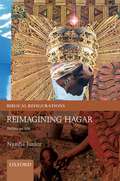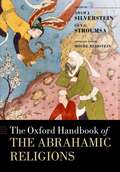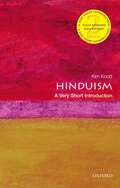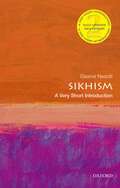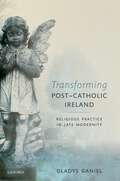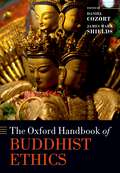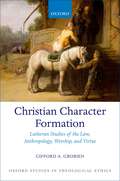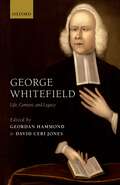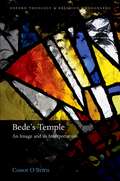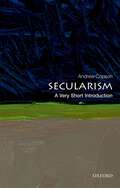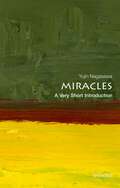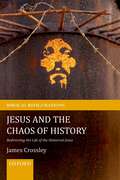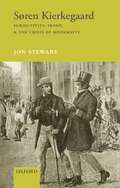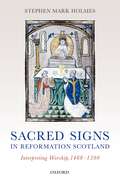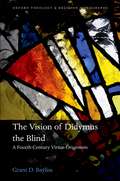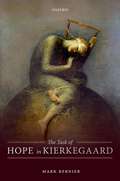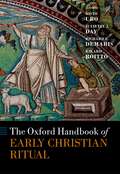- Table View
- List View
Reimagining Hagar: Blackness and Bible (Biblical Refigurations)
by Nyasha JuniorReimagining Hagar illustrates that while interpretations of Hagar as Black are not frequent within the entire history of her interpretation, such interpretations are part of strategies to emphasize elements of Hagar's story in order to associate or disassociate her from particular groups. It considers how interpreters engage markers of difference, including gender, ethnicity, status and their intersections in their portrayals of Hagar. Nyasha Junior offers a reception history that examines interpretations of Hagar with a focus on interpretations of Hagar as a Black woman. Reception history within biblical studies considers the use, impact, and influence of biblical texts and looks at a necessarily small number of points within the long history of the transmission of biblical texts. This volume covers a limited selection of interpretations over time that is not intended to be a representative sample of interpretations of Hagar. It is beyond the scope of this book to offer a comprehensive collection of interpretations of Hagar throughout the history of biblical interpretation or in popular culture. Junior argues for the African presence in biblical texts; identifies and responds to White supremacist interpretations; offers cultural-historical interpretation that attends to the history of biblical interpretation within Black communities; and provides ideological criticism that uses the African-American context as a reading strategy. Reimagining Hagar offers a history of interpretation, but also expands beyond interpretation among Black communities to consider how various interpreters have identified Hagar as Black.
Reimagining Hagar: Blackness and Bible (Biblical Refigurations)
by Nyasha JuniorReimagining Hagar illustrates that while interpretations of Hagar as Black are not frequent within the entire history of her interpretation, such interpretations are part of strategies to emphasize elements of Hagar's story in order to associate or disassociate her from particular groups. It considers how interpreters engage markers of difference, including gender, ethnicity, status and their intersections in their portrayals of Hagar. Nyasha Junior offers a reception history that examines interpretations of Hagar with a focus on interpretations of Hagar as a Black woman. Reception history within biblical studies considers the use, impact, and influence of biblical texts and looks at a necessarily small number of points within the long history of the transmission of biblical texts. This volume covers a limited selection of interpretations over time that is not intended to be a representative sample of interpretations of Hagar. It is beyond the scope of this book to offer a comprehensive collection of interpretations of Hagar throughout the history of biblical interpretation or in popular culture. Junior argues for the African presence in biblical texts; identifies and responds to White supremacist interpretations; offers cultural-historical interpretation that attends to the history of biblical interpretation within Black communities; and provides ideological criticism that uses the African-American context as a reading strategy. Reimagining Hagar offers a history of interpretation, but also expands beyond interpretation among Black communities to consider how various interpreters have identified Hagar as Black.
The Oxford Handbook of the Abrahamic Religions (Oxford Handbooks)
by Moshe BlidsteinThe Oxford Handbook of the Abrahamic Religions includes authoritative yet accessible studies on a wide variety of topics dealing comparatively with Judaism, Christianity, and Islam, as well as with the interactions between the adherents of these religions throughout history. The comparative study of the Abrahamic Religions has been undertaken for many centuries. More often than not, these studies reflected a polemical rather than an ecumenical approach to the topic. Since the nineteenth century, the comparative study of the Abrahamic Religions has not been pursued either intensively or systematically, and it is only recently that the comparative study of Judaism, Christianity, and Islam has received more serious attention. This volume contributes to the emergence and development of the comparative study of the Abrahamic religions, a discipline which is now in its formative stages. This Handbook includes both critical and supportive perspectives on the very concept of the Abrahamic religions and discussions on the role of the figure of Abraham in these religions. It features 32 essays, by the foremost scholars in the field, on the historical interactions between Abrahamic communities; on Holy Scriptures and their interpretation; on conceptions of religious history; on various topics and strands of religious thought, such as monotheism and mysticism; on rituals of prayer, purity, and sainthood, on love in the three religions and on fundamentalism. The volume concludes with three epilogues written by three influential figures in the Christian, Jewish, and Muslim communities, to provide a broader perspective on the comparative study of the Abrahamic religions. This ground-breaking work introduces readers to the challenges and rewards of studying these three religions together.
The Oxford Handbook of the Abrahamic Religions (Oxford Handbooks)
by Moshe BlidsteinThe Oxford Handbook of the Abrahamic Religions includes authoritative yet accessible studies on a wide variety of topics dealing comparatively with Judaism, Christianity, and Islam, as well as with the interactions between the adherents of these religions throughout history. The comparative study of the Abrahamic Religions has been undertaken for many centuries. More often than not, these studies reflected a polemical rather than an ecumenical approach to the topic. Since the nineteenth century, the comparative study of the Abrahamic Religions has not been pursued either intensively or systematically, and it is only recently that the comparative study of Judaism, Christianity, and Islam has received more serious attention. This volume contributes to the emergence and development of the comparative study of the Abrahamic religions, a discipline which is now in its formative stages. This Handbook includes both critical and supportive perspectives on the very concept of the Abrahamic religions and discussions on the role of the figure of Abraham in these religions. It features 32 essays, by the foremost scholars in the field, on the historical interactions between Abrahamic communities; on Holy Scriptures and their interpretation; on conceptions of religious history; on various topics and strands of religious thought, such as monotheism and mysticism; on rituals of prayer, purity, and sainthood, on love in the three religions and on fundamentalism. The volume concludes with three epilogues written by three influential figures in the Christian, Jewish, and Muslim communities, to provide a broader perspective on the comparative study of the Abrahamic religions. This ground-breaking work introduces readers to the challenges and rewards of studying these three religions together.
Hinduism: A Very Short Introduction (Very Short Introductions)
by Kim KnottHinduism is practised by nearly eighty per cent of India's population, and by some seventy million people outside India. In this Very Short Introduction, Kim Knott offers a succinct and authoritative overview of this major religion, and analyses the challenges facing it in the twenty-first century. She discusses key preoccupations of Hinduism such as the centrality of the Veda as religious texts, the role of Brahmins, gurus, and storytellers in the transmission of divine truths, and the cultural and moral importance of epics such as the Ramayana. In this second edition Knott considers the impact of changes in technology and the flourishing of social media on Hinduism, and looks at the presence of Hinduism in popular culture, considering pieces such as Sita Sings the Blues. She also analyses recent developments in India, and the impact issues such as Hindu nationalism and the politicization of Hinduism have on Hindus worldwide. ABOUT THE SERIES: The Very Short Introductions series from Oxford University Press contains hundreds of titles in almost every subject area. These pocket-sized books are the perfect way to get ahead in a new subject quickly. Our expert authors combine facts, analysis, perspective, new ideas, and enthusiasm to make interesting and challenging topics highly readable.
Hinduism: A Very Short Introduction (Very Short Introductions)
by Kim KnottHinduism is practised by nearly eighty per cent of India's population, and by some seventy million people outside India. In this Very Short Introduction, Kim Knott offers a succinct and authoritative overview of this major religion, and analyses the challenges facing it in the twenty-first century. She discusses key preoccupations of Hinduism such as the centrality of the Veda as religious texts, the role of Brahmins, gurus, and storytellers in the transmission of divine truths, and the cultural and moral importance of epics such as the Ramayana. In this second edition Knott considers the impact of changes in technology and the flourishing of social media on Hinduism, and looks at the presence of Hinduism in popular culture, considering pieces such as Sita Sings the Blues. She also analyses recent developments in India, and the impact issues such as Hindu nationalism and the politicization of Hinduism have on Hindus worldwide. ABOUT THE SERIES: The Very Short Introductions series from Oxford University Press contains hundreds of titles in almost every subject area. These pocket-sized books are the perfect way to get ahead in a new subject quickly. Our expert authors combine facts, analysis, perspective, new ideas, and enthusiasm to make interesting and challenging topics highly readable.
Sikhism: A Very Short Introduction (Very Short Introductions)
by Eleanor NesbittThe Sikh religion has a following of over 20 million people worldwide. However,events such as the verbal and physical attacks on Sikhs just after September 11, where Sikhs were being mistaken for Muslims, suggest that the Sikh faith still remains mysterious to many. This Very Short Introduction introduces newcomers to the meaning of the Sikh religious tradition, its teachings, practices, rituals and festivals. Eleanor Nesbitt highlights and contextualizes the key threads in the history of Sikhism, from the first Gurus to martyrdom, militarization, and the increasingly significant diaspora. Examining gender, caste, and the changes that are currently underway in the faith, Nesbitt considers contemporary Sikh identities and their role in our world. ABOUT THE SERIES: The Very Short Introductions series from Oxford University Press contains hundreds of titles in almost every subject area. These pocket-sized books are the perfect way to get ahead in a new subject quickly. Our expert authors combine facts, analysis, perspective, new ideas, and enthusiasm to make interesting and challenging topics highly readable.
Sikhism: A Very Short Introduction (Very Short Introductions)
by Eleanor NesbittThe Sikh religion has a following of over 20 million people worldwide. However,events such as the verbal and physical attacks on Sikhs just after September 11, where Sikhs were being mistaken for Muslims, suggest that the Sikh faith still remains mysterious to many. This Very Short Introduction introduces newcomers to the meaning of the Sikh religious tradition, its teachings, practices, rituals and festivals. Eleanor Nesbitt highlights and contextualizes the key threads in the history of Sikhism, from the first Gurus to martyrdom, militarization, and the increasingly significant diaspora. Examining gender, caste, and the changes that are currently underway in the faith, Nesbitt considers contemporary Sikh identities and their role in our world. ABOUT THE SERIES: The Very Short Introductions series from Oxford University Press contains hundreds of titles in almost every subject area. These pocket-sized books are the perfect way to get ahead in a new subject quickly. Our expert authors combine facts, analysis, perspective, new ideas, and enthusiasm to make interesting and challenging topics highly readable.
Transforming Post-Catholic Ireland: Religious Practice in Late Modernity
by Gladys GanielTransforming Post-Catholic Ireland is the first major book to explore the dynamic religious landscape of contemporary Ireland, north and south, and to analyse the island's religious transition. It confirms that the Catholic Church's long-standing 'monopoly' has well and truly disintegrated, replaced by a mixed, post-Catholic religious 'market' featuring new and growing expressions of Protestantism, as well as other religions. It describes how people of faith are developing 'extra-institutional' expressions of religion, keeping their faith alive outside or in addition to the institutional Catholic Church. Drawing on island-wide surveys of clergy and laypeople, as well as more than 100 interviews, Gladys Ganiel describes how people of faith are engaging with key issues such as increased diversity, reconciliation to overcome the island's sectarian past, and ecumenism. Ganiel argues that extra-institutional religion is especially well-suited to address these and other issues due to its freedom and flexibility when compared to traditional religious institutions. She explains how those who practice extra-institutional religion have experienced personal transformation, and analyses the extent that they have contributed to wider religious, social, and political change. On an island where religion has caused much pain, from clerical sexual abuse scandals, to sectarian violence, to a frosty reception for some immigrants, those who practice their faith outside traditional religious institutions may hold the key to transforming post-Catholic Ireland into a more reconciled society.
The Oxford Handbook of Buddhist Ethics (Oxford Handbooks)
Many forms of Buddhism, divergent in philosophy and style, emerged as Buddhism filtered out of India into other parts of Asia. Nonetheless, all of them embodied an ethical core that is remarkably consistent. Articulated by the historical Buddha in his first sermon, this moral core is founded on the concept of karma—that intentions and actions have future consequences for an individual—and is summarized as Right Speech, Right Action, and Right Livelihood, three of the elements of the Eightfold Path. Although they were later elaborated and interpreted in a multitude of ways, none of these core principles were ever abandoned. The Oxford Handbook of Buddhist Ethics provides a comprehensive overview of the field of Buddhist ethics in the twenty-first century. The Handbook discusses the foundations of Buddhist ethics focusing on karma and the precepts looking at abstinence from harming others, stealing, and intoxication. It considers ethics in the different Buddhist traditions and the similarities they share, and compares Buddhist ethics to Western ethics and the psychology of moral judgments. The volume also investigates Buddhism and society analysing economics, environmental ethics, and Just War ethics. The final section focuses on contemporary issues surrounding Buddhist ethics, including gender, sexuality, animal rights, and euthanasia. This groundbreaking collection offers an indispensable reference work for students and scholars of Buddhist ethics and comparative moral philosophy.
The Oxford Handbook of Buddhist Ethics (Oxford Handbooks)
by Daniel Cozort and James Mark ShieldsMany forms of Buddhism, divergent in philosophy and style, emerged as Buddhism filtered out of India into other parts of Asia. Nonetheless, all of them embodied an ethical core that is remarkably consistent. Articulated by the historical Buddha in his first sermon, this moral core is founded on the concept of karma—that intentions and actions have future consequences for an individual—and is summarized as Right Speech, Right Action, and Right Livelihood, three of the elements of the Eightfold Path. Although they were later elaborated and interpreted in a multitude of ways, none of these core principles were ever abandoned. The Oxford Handbook of Buddhist Ethics provides a comprehensive overview of the field of Buddhist ethics in the twenty-first century. The Handbook discusses the foundations of Buddhist ethics focusing on karma and the precepts looking at abstinence from harming others, stealing, and intoxication. It considers ethics in the different Buddhist traditions and the similarities they share, and compares Buddhist ethics to Western ethics and the psychology of moral judgments. The volume also investigates Buddhism and society analysing economics, environmental ethics, and Just War ethics. The final section focuses on contemporary issues surrounding Buddhist ethics, including gender, sexuality, animal rights, and euthanasia. This groundbreaking collection offers an indispensable reference work for students and scholars of Buddhist ethics and comparative moral philosophy.
Christian Character Formation: Lutheran Studies of the Law, Anthropology, Worship, and Virtue (Oxford Studies in Theological Ethics)
by Gifford A. GrobienChristian Character Formation investigates worship and formation in view of Christian anthropology, particularly union with Christ. Traditions which value justification by faith wrestle to some degree with how to describe and encourage ethical formation when salvation and righteousness are presented as gracious and complete. The dialectic of law and gospel has suggested to some that forgiveness and the advocacy of ethical norms contend with each other. By viewing justification and formation in light of Christ's righteousness which is both imputed and imparted, it is more readily seen that forgiveness and ethics complement each other. In justification, God converts a person, by which he grants new character. Traditional Lutheran anthropology says that this regeneration grants a new nature in mystical union with Jesus Christ. By exploring the Finnish Luther School led by Tuomo Mannermaa, Gifford A. Grobien explains how union with Christ imparts righteousness and the corresponding new character to the believer. Furthermore, as means of grace, the Word and sacraments are the means of establishing union with Christ and nurturing new character. Considering Oswald Bayer's "suffering" the word of Christ, Louis-Marie Chauvet's "symbolic order" and Bernd Wannenwetsch's understanding of worship as Christianity's unique "form of life," Grobien argues that worship practices are the foundational and determinative context in which grace is offered and in which the distinctively Christian ethos supports virtues consistent with Christian character. This understanding is also coordinated with Stanley Hauerwas's narrative ethics and Luther's teaching of virtue and good works in view of the Ten Commandments.
George Whitefield: Life, Context, and Legacy
by David Ceri Jones Geordan HammondGeorge Whitefield (1714-70) was one of the best known and most widely travelled evangelical revivalist in the eighteenth century. For a time in the middle decades of the eighteenth century, Whitefield was the most famous person on both sides of the Atlantic. An Anglican clergyman, Whitefield soon transcended his denominational context as his itinerant ministry fuelled a Protestant renewal movement in Britain and the American colonies. He was one of the founders of Methodism, establishing a distinct brand of the movement with a Calvinist orientation, but also the leading itinerant and international preacher of the evangelical movement in its early phase. Called the 'Apostle of the English empire', he preached throughout the whole of the British Isles and criss-crossed the Atlantic seven times, preaching in nearly every town along the eastern seaboard of America. His own fame and popularity were such that he has been dubbed 'Anglo-America's first religious celebrity', and even one of the 'Founding Fathers of the American Revolution'. This collection offers a major reassessment of Whitefield's life, context, and legacy, bringing together a distinguished interdisciplinary team of scholars from both sides of the Atlantic. In chapters that cover historical, theological, and literary themes, many addressed for the first time, the volume suggests that Whitefield was a highly complex figure who has been much misunderstood. Highly malleable, Whitefield's persona was shaped by many audiences during his lifetime and continues to be highly contested.
Bede's Temple: An Image and its Interpretation (Oxford Theology and Religion Monographs)
by Conor O'BrienThis volume examines the use of the image of the Jewish temple in the writings of the Anglo-Saxon theologian and historian, Bede (d. 735). The various Jewish holy sites described in the Bible possessed multiple different meanings for Bede and therefore this imagery provides an excellent window into his thought. Bede's Temple: An Image and its Interpretation examines Bede's use of the temple to reveal his ideas of history, the universe, Christ, the Church, and the individual Christian. Across his wide body of writings Bede presented an image of unity, whether that be the unity of Jew and gentile in the universal Church, or the unity of human and divine in the incarnate Christ, and the temple-image provided a means of understanding and celebrating that unity. Conor O'Brien argues that Bede's understanding of the temple was part of the shared spirituality and communal discourse of his monastery at Wearmouth-Jarrow, in particular as revealed in the great illuminated Bible made there: the Codex Amiatinus. Studying the temple in Bede's works reveals not just an individual genius, but a monastic community engaged actively in scriptural interpretation and religious reflection. O'Brien makes an important contribution to our understanding of early Anglo-Saxon England's most important author, the world in which he lived, and the processes that inspired his work.
Secularism: A Very Short Introduction (Very Short Introductions)
by Andrew CopsonUntil the modern period the integration of church (or other religion) and state (or political life) had been taken for granted. The political order was always tied to an official religion in Christian Europe, pre-Christian Europe, and in the Arabic world. But from the eighteenth century onwards, some European states began to set up their political order on a different basis. Not religion, but the rule of law through non-religious values embedded in constitutions became the foundation of some states - a movement we now call secularism. In others, a de facto secularism emerged as political values and civil and criminal law altered their professed foundation from a shared religion to a non-religious basis. Today secularism is an increasingly hot topic in public, political, and religious debate across the globe. It is embodied in the conflict between secular republics - from the US to India - and the challenges they face from resurgent religious identity politics; in the challenges faced by religious states like those of the Arab world from insurgent secularists; and in states like China where calls for freedom of belief are challenging a state imposed non-religious worldview. In this Very Short Introduction Andrew Copson tells the story of secularism, taking in momentous episodes in world history, such as the great transition of Europe from religious orthodoxy to pluralism, the global struggle for human rights and democracy, and the origins of modernity. He also considers the role of secularism when engaging with some of the most contentious political and legal issues of our time: 'blasphemy', 'apostasy', religious persecution, religious discrimination, religious schools, and freedom of belief and freedom of thought in a divided world. Previously published in hardback as Secularism: Politics, Religion, and Freedom ABOUT THE SERIES: The Very Short Introductions series from Oxford University Press contains hundreds of titles in almost every subject area. These pocket-sized books are the perfect way to get ahead in a new subject quickly. Our expert authors combine facts, analysis, perspective, new ideas, and enthusiasm to make interesting and challenging topics highly readable.
Secularism: A Very Short Introduction (Very Short Introductions)
by Andrew CopsonUntil the modern period the integration of church (or other religion) and state (or political life) had been taken for granted. The political order was always tied to an official religion in Christian Europe, pre-Christian Europe, and in the Arabic world. But from the eighteenth century onwards, some European states began to set up their political order on a different basis. Not religion, but the rule of law through non-religious values embedded in constitutions became the foundation of some states - a movement we now call secularism. In others, a de facto secularism emerged as political values and civil and criminal law altered their professed foundation from a shared religion to a non-religious basis. Today secularism is an increasingly hot topic in public, political, and religious debate across the globe. It is embodied in the conflict between secular republics - from the US to India - and the challenges they face from resurgent religious identity politics; in the challenges faced by religious states like those of the Arab world from insurgent secularists; and in states like China where calls for freedom of belief are challenging a state imposed non-religious worldview. In this Very Short Introduction Andrew Copson tells the story of secularism, taking in momentous episodes in world history, such as the great transition of Europe from religious orthodoxy to pluralism, the global struggle for human rights and democracy, and the origins of modernity. He also considers the role of secularism when engaging with some of the most contentious political and legal issues of our time: 'blasphemy', 'apostasy', religious persecution, religious discrimination, religious schools, and freedom of belief and freedom of thought in a divided world. Previously published in hardback as Secularism: Politics, Religion, and Freedom ABOUT THE SERIES: The Very Short Introductions series from Oxford University Press contains hundreds of titles in almost every subject area. These pocket-sized books are the perfect way to get ahead in a new subject quickly. Our expert authors combine facts, analysis, perspective, new ideas, and enthusiasm to make interesting and challenging topics highly readable.
Miracles: A Very Short Introduction (Very Short Introductions)
by Yujin NagasawaJesus turned water into wine, Mohammad split the moon into two, and Buddha walked and spoke immediately upon birth. According to recent statistics, even in the present age of advanced science and technology, most people believe in miracles. In fact, newspapers and television regularly report alleged miracles, such as recoveries from incurable diseases, extremely unlikely coincidences, and religious signs and messages on unexpected objects. In this book the award-winning author and philosopher Yujin Nagasawa addresses some of our most fundamental questions concerning miracles. What exactly is a miracle? What types of miracles are believed in the world's great religions? What do recent scientific findings tell us about miracles? Can we rationally believe that miracles have really taken place? Can there be acts that are more religiously significant than miracles? Drawing on a vast variety of fascinating examples from across the major religions, Nagasawa discusses the lively debate on miracles that ranges from reported miracles in ancient scriptures in the East and West to cutting-edge scientific research on belief formation. Throughout, he drives us to ask ourselves if and how we can still believe in in miracles in the twenty-first century. ABOUT THE SERIES: The Very Short Introductions series from Oxford University Press contains hundreds of titles in almost every subject area. These pocket-sized books are the perfect way to get ahead in a new subject quickly. Our expert authors combine facts, analysis, perspective, new ideas, and enthusiasm to make interesting and challenging topics highly readable.
Miracles: A Very Short Introduction (Very Short Introductions)
by Yujin NagasawaJesus turned water into wine, Mohammad split the moon into two, and Buddha walked and spoke immediately upon birth. According to recent statistics, even in the present age of advanced science and technology, most people believe in miracles. In fact, newspapers and television regularly report alleged miracles, such as recoveries from incurable diseases, extremely unlikely coincidences, and religious signs and messages on unexpected objects. In this book the award-winning author and philosopher Yujin Nagasawa addresses some of our most fundamental questions concerning miracles. What exactly is a miracle? What types of miracles are believed in the world's great religions? What do recent scientific findings tell us about miracles? Can we rationally believe that miracles have really taken place? Can there be acts that are more religiously significant than miracles? Drawing on a vast variety of fascinating examples from across the major religions, Nagasawa discusses the lively debate on miracles that ranges from reported miracles in ancient scriptures in the East and West to cutting-edge scientific research on belief formation. Throughout, he drives us to ask ourselves if and how we can still believe in in miracles in the twenty-first century. ABOUT THE SERIES: The Very Short Introductions series from Oxford University Press contains hundreds of titles in almost every subject area. These pocket-sized books are the perfect way to get ahead in a new subject quickly. Our expert authors combine facts, analysis, perspective, new ideas, and enthusiasm to make interesting and challenging topics highly readable.
Jesus and the Chaos of History: Redirecting the Life of the Historical Jesus (Biblical Refigurations)
by James CrossleyIn Jesus and the Chaos of History, James Crossley looks at the way the earliest traditions about Jesus interacted with a context of social upheaval and the ways in which this historical chaos of the early first century led to a range of ideas which were taken up, modified, ignored, and reinterpreted in the movement that followed. Crossley examines how the earliest Palestinian tradition intersected with social upheaval and historical change and how accidental, purposeful, discontinuous, contradictory, and implicit meanings in the developments of ideas appeared in the movement that followed. He considers the ways seemingly egalitarian and countercultural ideas co-exist with ideas of dominance and power and how human reactions to socio-economic inequalities can end up mimicking dominant power. In this case, the book analyses how a Galilean 'protest' movement laid the foundations for its own brand of imperial rule. This evaluation is carried out in detailed studies on the kingdom of God and 'Christology', 'sinners' and purity, and gender and revolution.
Søren Kierkegaard: Subjectivity, Irony, & the Crisis of Modernity
by Jon StewartSøren Kierkegaard: Subjectivity, Irony, and the Crisis of Modernity examines the thought of Søren Kierkegaard, a unique figure, who has freeired, provoked, fascinated, and irritated people ever since he walked the streets of Copenhagen. At the end of his life, Kierkegaard said that the only model he had for his work was the Greek philosopher Socrates. This work takes this statement as its point of departure. Jon Stewart explores what Kierkegaard meant by this and to show how different aspects of his writing and argumentative strategy can be traced back to Socrates. The main focus is The Concept of Irony, which is a key text at the beginning of Kierkegaard's literary career. Although it was an early work, it nevertheless played a determining role in his later development and writings. Indeed, it can be said that it laid the groundwork for much of what would appear in his later famous books such as Either/Or and Fear and Trembling.
Søren Kierkegaard: Subjectivity, Irony, & the Crisis of Modernity
by Jon StewartSøren Kierkegaard: Subjectivity, Irony, and the Crisis of Modernity examines the thought of Søren Kierkegaard, a unique figure, who has freeired, provoked, fascinated, and irritated people ever since he walked the streets of Copenhagen. At the end of his life, Kierkegaard said that the only model he had for his work was the Greek philosopher Socrates. This work takes this statement as its point of departure. Jon Stewart explores what Kierkegaard meant by this and to show how different aspects of his writing and argumentative strategy can be traced back to Socrates. The main focus is The Concept of Irony, which is a key text at the beginning of Kierkegaard's literary career. Although it was an early work, it nevertheless played a determining role in his later development and writings. Indeed, it can be said that it laid the groundwork for much of what would appear in his later famous books such as Either/Or and Fear and Trembling.
Sacred Signs in Reformation Scotland: Interpreting Worship, 1488-1590
by Stephen Mark HolmesSacred Signs in Reformation Scotland is the first study of how public worship was interpreted in Renaissance Scotland and offers a radically new way of understanding the Scottish Reformation. It first defines the history and method of 'liturgical interpretation' (using the methods of medieval Biblical exegesis to explain worship), then shows why it was central to medieval and early modern Western European religious culture. The rest of the book uses Scotland as a case study for a multidisciplinary investigation of the place of liturgical interpretation in this culture. Stephen Mark Holmes uses the methods of 'book history' to discover the place of liturgical interpretation in education, sermons and pastoral practice and also investigates its impact on material culture, especially church buildings and furnishings. A study of books and their owners reveals networks of clergy in Scotland committed to the liturgy and Catholic reform, especially the 'Aberdeen liturgists'. Holmes corrects current scholarship by showing that their influence lasted beyond 1560 and suggests that they created the distinctive religious culture of North-East Scotland (later a centre of Catholic recusancy, Episcopalianism and Jacobitism). The final two chapters investigate what happened to liturgical interpretation in Scottish religious culture after the Protestant Reformation of 1559-60, showing that while it declined in importance in Catholic circles, a Reformed Protestant version of liturgical interpretation was created and flourished which used exactly the same method to produce both an interpretation of the Reformed sacramental rites and an 'anti-commentary' on Catholic liturgy. The book demonstrates an important continuity across the Reformation divide arguing that the 'Scottish Reformation' is best seen as both Catholic and Protestant, with the reformers on both sides having more in common than they or subsequent historians have allowed.
The Vision of Didymus the Blind: A Fourth-Century Virtue-Origenism (Oxford Theology and Religion Monographs)
by Grant D. BaylissAn independent teacher, based in Alexandria throughout the second half of the fourth century, Didymus appealed to many within the broadly Origenist currents of Egyptian asceticism, including Jerome, Rufinus, and Evagrius. His commentaries, lecture-notes, and theological treatises show him specifically committed to the legacy of Origen and Philo, rather than a broader 'Alexandrian' or noetic reading of Scripture. Yet his concern was not to answer classic 'Antiochene' critique but rather offer a faithful continuation of many aspects of Origen's thought and exegesis, now made consistent with the broader anti-subordinationist developments in Nicene faith from the 350s onwards. In doing so he made virtue a primary category of reality, human existence, and life, in ways that go beyond the traditional philosophical tropes. This 'turn to virtue' draws parallels with wider fourth-century trends but it sets Didymus' own Origenism apart from those of other Origenists, such as Eusebius of Caesarea or Evagrius of Pontus. Thus detailed discussion focuses on Didymus' portrayal of virtue, sin, and passion, which together form the constant hermeneutical terrain for his anagogical exegesis and exhortation to a dynamic process of ascent. Speculative comments of Origen on the pre-existence of the soul, salvation of the devil, pre-passion, and the sin of Adam are shown to be reframed, both to aid the individual's navigation of the return to virtue and to answer the challenge of contemporary Manichaean and Apollinarian beliefs.
The Task of Hope in Kierkegaard
by Mark BernierPhilosophers of religion are often caught up with the epistemic justification of their religious beliefs, rather than the qualities of the religious life that make it valuable. Mark Bernier argues that hope is one of the most important of such qualities, and is an essential thread that connects despair, faith, and the self. The Task of Hope in Kierkegaard reconstructs Kierkegaard's theory of hope, which involves the distinction between mundane and authentic hope, and makes three principal claims. Firstly, while despair involves the absence of hope, a rejection of oneself, and a turn away from one's relation to God, despair is fundamentally an unwillingness to hope. This unwillingness is directed toward authentic hope, conceived of by Kierkegaard as an expectation for the possibility of the good. Secondly, hope is not simply an ancillary activity of the self; rather, the task of becoming a self is essentially constituted by hope. Thus, when in despair one is unwilling to hope, one is in fact rejecting one's task of becoming a self. Thirdly, faith stands in opposition to despair precisely because it is a willingness to hope. An essential role of faith is to secure the ground for hope, and in this way faith secures the ground for the self. In short, authentic hope (what Kierkegaard calls spiritual hope) is not merely a fringe element, but is essential to Kierkegaard's project of the self.
The Oxford Handbook of Early Christian Ritual (Oxford Handbooks)
by Rikard RoittoScholars of religion have long assumed that ritual and belief constitute the fundamental building blocks of religious traditions and that these two components of religion are interrelated and interdependent in significant ways. Generations of New Testament and Early Christian scholars have produced detailed analyses of the belief systems of nascent Christian communities, including their ideological and political dimensions, but have by and large ignored ritual as an important element of early Christian religion and as a factor contributing to the rise and the organization of the movement. In recent years, however, scholars of early Christianity have begun to use ritual as an analytical tool for describing and explaining Christian origins and the early history of the movement. Such a development has created a momentum toward producing a more comprehensive volume on the ritual world of Early Christianity employing advances made in the field of ritual studies. The Oxford Handbook of Early Christian Ritual gives a manifold account of the ritual world of early Christianity from the beginning of the movement up to the fifth century. The volume introduces relevant theories and approaches; central topics of ritual life in the cultural world of early Christianity; and important Christian ritual themes and practices in emerging Christian groups and factions.
